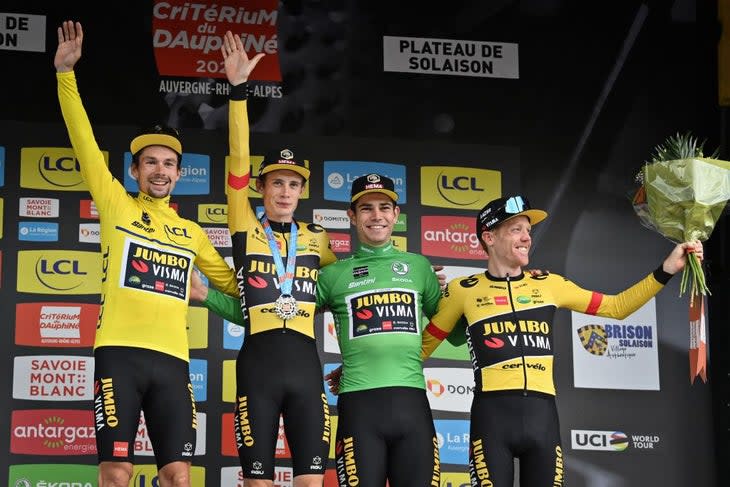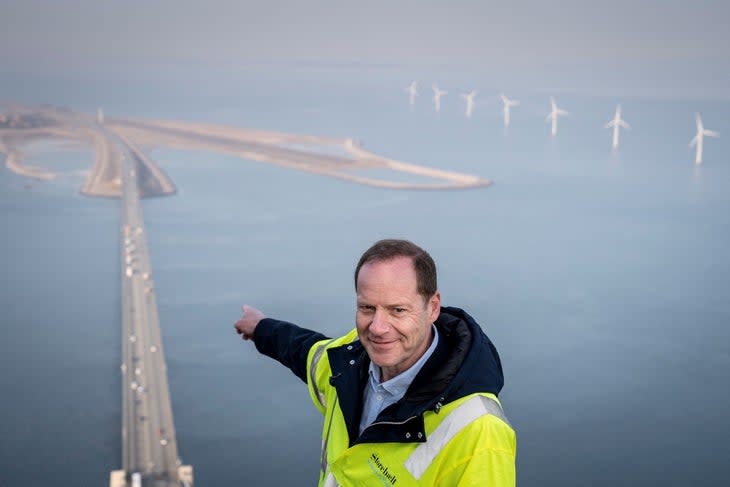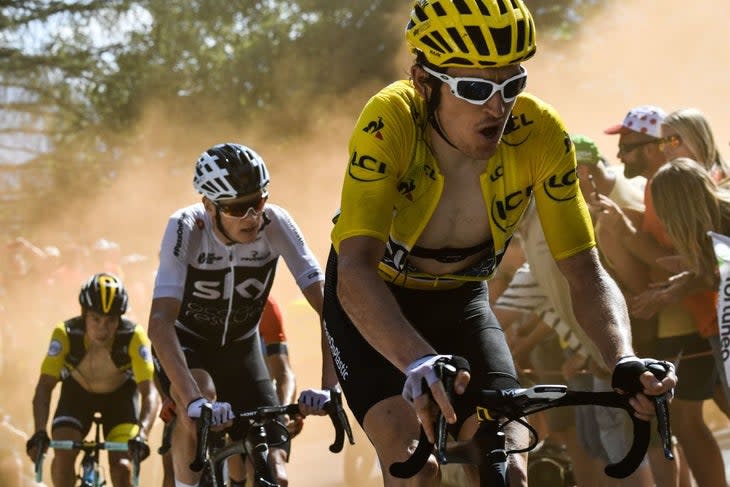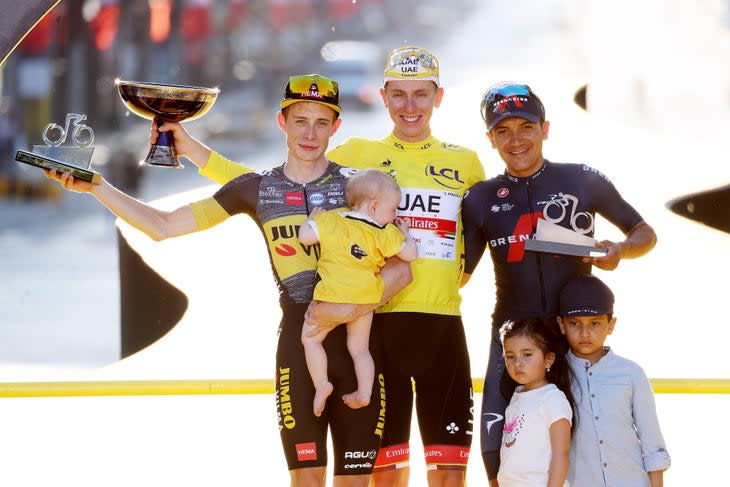2022 Tour de France essential race preview: Who will win the yellow jersey?
- Oops!Something went wrong.Please try again later.
This article originally appeared on Velo News
Dates: July 1-24
Stages: 21
Rest days: 3
Start: Copenhagen
Finish: Paris
The 2022 Tour de France starts with a bang in Copenhagen and ends with a flourish with its traditional laps on the Champs-Elysees.
In between, there are 21 stages, more than 3,500km of racing, and enough drama and storylines to fill out a Netflix series … oh, wait.
The 109th edition of cycling’s most important stage race brings all the pageantry, prestige, and pressure that accompanies the annual grande boucle.
Summer’s annual big loop features some unique twists and turns just like most years, with the Tour’s most ambitious grand depart to date in Denmark. There are some new climbs, a return to the cobblestones, and some fresh faces promising to light things up.
Also read:
Yet more so than in most sports, the actual Tour de France is bigger than any individual star. At least that’s what the French like to believe, especially those working inside the ASO building in the tony west suburb of Paris.
The 2022 Tour will see a clash of Slovenians, with Primoz Roglic steeled and determined to beat back his compatriot Tadej Pogacar, who seems destined to rule the Tour roost for quite some time.
Behind the Jumbo-Visma vs. UAE Team Emirates clash of titans, the proud lady of the peloton Ineos Grenadiers is intent on proving it can still bend the Tour to its will. Bora-Hansgrohe is also trying to elbow into the elite.
The fight for yellow always dominates the narrative, but there will be plenty of subplots with the battle for the green jersey and the hunt for stage wins that can make or break a career.
The Tour never disappoints, yet because expectations are often so high, it’s rare that the race fully satisfies.
A challenging route should keep things interesting all the way from Copenhagen to Paris. Let’s dive in:
Who can beat Tadej Pogacar?
The short answer: apparently only his own bad luck.
VeloNews plied the peloton in June at the Criterium du Dauphine asking the top pros if Pogacar had a weak spot that a rival could exploit, and the universal answer was no.
“Tadej is a very complete rider, he is very good in all terrain. Every race he goes to, he is the favorite, also for the Tour,” said last year’s runner-up Jonas Vingegaard. “Of course, we have to look at it, and use our strength if we can find any weakness. I wouldn't say he has any weaknesses.”
Pogacar is cycling’s Superman. He can climb, time trial, sprint, handle his bike, manage the pressure, and kiss the babies, too.
At 23, Pogacar’s already won two yellow jerseys, and seems destined for many more.
Some viewed Pogacar’s team as a relative weakness, but new signings such as George Bennett and Marc Soler only bolster what already is a very good support system.
Also read: George Bennett’s ultimate challenge at the Tour
Everyone agrees that this is Pogacar’s race to lose, so the question begs, who can beat him?
First in line are Primoz Roglic and Vingegaard. They’ve finished second to Pogacar the past two seasons, with Roglic suffering the stunning defeat in the final time trial in 2020. Last year, Vingegaard surprised to stay close to Pogacar for three weeks.
Jumbo-Visma is going all-in with a deep team, though a COVID exit from the Tour de Suisse didn’t help. Absolute domination at the Criterium du Dauphine in June raised expectations that Jumbo-Visma is ready.
Can one team be stronger than one rider? Jumbo-Visma is betting on it.

Behind these two behemoths is Ineos Grenadiers, the UK super-team that dominated the Tour for much of a decade. Without a confirmed winner like Chris Froome or the injured Egan Bernal, the team will struggle to equal the Slovenians.
Adam Yates, Dani Martinez and perhaps a revived Geraint Thomas can push for the podium, and the team will ride the experience and knowledge that carried them to the heights during the peak years of the Wiggins/Froome era, when the team won seven tours in eight years by four different riders.
Bora-Hansgrohe, bolstered by its Giro d’Italia victory, will try to raid the party with Aleksandr Vlasov. A podium would confirm the team’s arrival to the elite.
Behind them, the list gets pretty thin pretty fast. Maybe one of the “Class of 1990” will find new wings, with Thibaut Pinot, Nairo Quintana, or Romain Bardet. EF Education-EasyPost brings Rigoberto Uran and perhaps Enric Mas can step up for Movistar.
Week One: Stages to press all skills

The 2022 Tour ventures to Denmark for three stages in what is the furthest ranging start for the Tour in race history.
The first yellow jersey is up for grabs in an old-school urban time trial course that should favor Filippo Ganna, Wout van Aert, or Stefan Kung, with the GC favorites keen to limit losses or take gains.
Much has been made about the first week of this year’s Tour, and rightly so. Two tricky road stages push the peloton out into the flatlands of Denmark, with stage 2 crossing a 20km bridge that could split in crosswinds. Stage 3 traces narrow farm roads that will put the tension to maximum level to avoid crashes.
Week One is for the sprinters, and once the Tour lands back in France stage 4 to Calais will see another chance for the fast finishers. Sprinters should have up to six perhaps even seven chances in this Tour, but they will have to work for them after stage 4.
Also read: Could an 18km bridge ruin the GC hopes of climbers?
Stage 5 takes the Tour onto the treacherous cobbled sectors featured in Paris-Roubaix. The debate continues to rage whether or not it’s fair to bring skinny, 65kg GC specialists and climbers over the pave, but surviving this stage with GC options fully intact will prove decisive.
The first real GC selection comes fast in the stage 7 summit finish at La Planche-des-Belles-Filles. It’s here where Pogacar crushed Roglic in a climbing time trial two years ago. This time, the time differences won’t be as pronounced except for anyone losing the wheel.
Two transition stages across Switzerland lead to the Tour’s first mountaintop finish at Chatel les Portes du Soleil, a first-category climb that will separate the chafe from the wheat, and set things up for the Alps.
Week Two: A return to Alpe d’Huez

Week Two pushes deep into the French Alps, with stage with stage 10 climbing Megeve with a second-category summit finale.
The 11th stage takes in the Lacetes de Montverrier, Col du Telegraphe and Col du Galibier for the HC summit at Col de Granon, the first of back-to-back summit finales that put perhaps a permanent order on the GC hierarchy.
Also read: Inside the Ineos Grenadiers’ long list
Stage 12 returns to the famed switchbacks to Alpe d’Huez, which should see the French in fever pitch to celebrate Bastille Day. The Galibier-Croix-de-Fer double sets the stage for a perhaps defining moment in this Tour, and it’s barely halfway over.
The week winds down with two transition stages well-suited for breakaways to bring the peloton to the base of the Pyrenees for the closing act.
Week Three: Pyrenees and final TT

A transition stage will bring the peloton into the short, but explosive 129.7km 17th stage that packs in the Col d'Aspin (12km at 6.5%), Hourquette d'Anzican (8.2km at 5.1%) and Col de Val-Louron-Azet (10.7km at 6.8%) before climbing to Peyragudes (8km at 7.8%).
The Tour’s final major summit finale comes at Hautacam, with passages over Col d’Aubisque and Col de Spandelles to set up the final battle. The Hautacam gets steeper as it climbs higher, and often has proven decisive in previous Tours.
Also read: All the details on the 2022 Tour de France route
The Tour’s not done yet. Stage 19 should be a mass sprint, if there are any legs left in the bunch to chase. Any loose strings will be tidied up in the 40.7km individual time trial from Lacapelle-Marival to Rocamadour. The rolling terrain features a few minor climbs, so it is a pure power course and for anyone left with strength in their legs.
The fun wraps up for the final laps on the Champs-Elysees on July 24.
2021 Tour de France podium
Tadej Pogacar (UAE Team Emirates)
Jonas Vingegaard (Jumbo-Visma) at 5:20
Richard Carapaz (Ineos Grenadiers) at 7:03
Green jersey: Mark Cavendish (Deceuninck-Quick-Step)
Climber’s jersey: Tadej Pogacar
Youth jersey: Tadej Pogacar
Best team: Bahrain-Victorious

Previous winners
2021 -- Tadej Pogacar
2020 -- Tadej Pogacar
2019 -- Egan Bernal
2018 -- Geraint Thomas
2017 -- Chris Froome
2016 -- Chris Froome
2015 -- Chris Froome
2014 -- Vincenzo Nibali
2013 -- Chris Froome
2012 -- Bradley Wiggins
For exclusive access to all of our fitness, gear, adventure, and travel stories, plus discounts on trips, events, and gear, sign up for Outside+ today.

